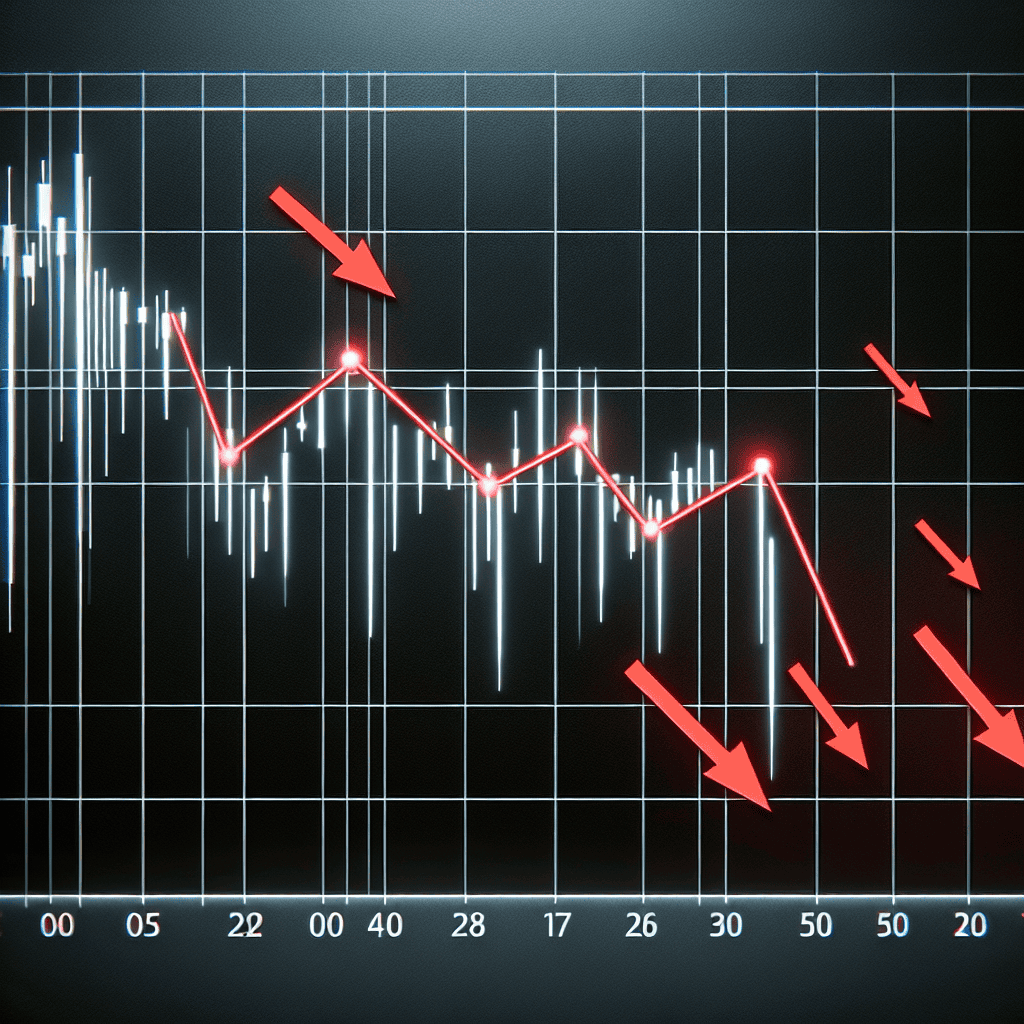“Market Momentum Stalls: S&P 500 Faces Consecutive Setbacks, Pausing the Rally”
Introduction
The S&P 500, a key benchmark for U.S. equities, has recently experienced consecutive losses, interrupting a rally that had buoyed investor sentiment. This downturn comes amid a backdrop of economic uncertainty, fluctuating interest rates, and geopolitical tensions, which have collectively contributed to market volatility. Investors are now closely monitoring economic indicators and corporate earnings reports to gauge the potential for a sustained recovery or further declines. The recent losses underscore the fragility of the market’s earlier gains and highlight the challenges facing the broader economy.
Impact Of Consecutive Losses On S&P 500 Investors
The recent consecutive losses in the S&P 500 have raised concerns among investors, halting a rally that had previously instilled a sense of optimism in the market. This downturn has prompted a reevaluation of investment strategies, as stakeholders seek to understand the underlying factors contributing to this shift. The S&P 500, a benchmark index that tracks the performance of 500 of the largest publicly traded companies in the United States, serves as a barometer for the overall health of the stock market. Consequently, its performance is closely monitored by investors, analysts, and policymakers alike.
The impact of these consecutive losses is multifaceted, affecting both individual and institutional investors. For individual investors, the decline in the S&P 500 can lead to a decrease in the value of their portfolios, particularly for those heavily invested in index funds or exchange-traded funds (ETFs) that track the index. This can result in a reduction in personal wealth and may prompt some investors to reconsider their risk tolerance and asset allocation. Moreover, the psychological impact of seeing portfolio values diminish can lead to increased anxiety and a potential shift towards more conservative investment strategies.
Institutional investors, such as pension funds, mutual funds, and insurance companies, also feel the repercussions of the S&P 500’s downturn. These entities often have significant exposure to the index, and a sustained decline can affect their ability to meet future obligations. For instance, pension funds rely on investment returns to fulfill their commitments to retirees, and a prolonged period of losses could necessitate adjustments in their funding strategies. Similarly, mutual funds may experience increased redemptions as investors seek to minimize losses, leading to potential liquidity challenges.
In addition to the direct financial implications, the consecutive losses in the S&P 500 can influence investor sentiment and market dynamics. A decline in the index may signal broader economic concerns, such as slowing growth or geopolitical tensions, prompting investors to adopt a more cautious approach. This shift in sentiment can lead to increased market volatility, as investors react to new information and adjust their positions accordingly. Furthermore, the losses may prompt a reassessment of corporate earnings expectations, as companies face potential headwinds that could impact their profitability.
Despite these challenges, it is important to recognize that market fluctuations are a natural part of the investment landscape. Historically, the S&P 500 has experienced periods of decline followed by recovery, underscoring the importance of maintaining a long-term perspective. For investors, this means focusing on diversification and adhering to a disciplined investment strategy that aligns with their financial goals and risk tolerance. By doing so, they can better navigate the inherent uncertainties of the market and position themselves for future growth.
In conclusion, the consecutive losses in the S&P 500 have significant implications for investors, affecting both their financial well-being and investment strategies. While the immediate impact may be concerning, it is crucial to maintain a balanced perspective and recognize the cyclical nature of the market. By staying informed and adapting to changing conditions, investors can mitigate risks and capitalize on opportunities that arise in the aftermath of market downturns. As the situation continues to evolve, ongoing analysis and strategic adjustments will be essential for navigating the complexities of the investment landscape.
Historical Analysis Of S&P 500 Losing Streaks
The S&P 500, a benchmark index that represents the performance of 500 leading publicly traded companies in the United States, has recently experienced consecutive losses, effectively halting a rally that had captured the attention of investors and analysts alike. To understand the implications of this downturn, it is essential to examine the historical context of losing streaks within the S&P 500, as these periods can offer valuable insights into market behavior and investor sentiment.
Historically, the S&P 500 has experienced numerous losing streaks, each varying in duration and severity. These streaks are often influenced by a myriad of factors, including economic indicators, geopolitical events, and shifts in investor confidence. By analyzing past occurrences, one can discern patterns and potential outcomes that may inform current and future investment strategies. For instance, during the financial crisis of 2008, the S&P 500 endured a prolonged period of decline, driven by widespread economic instability and uncertainty. This downturn was characterized by significant volatility, as investors grappled with the implications of a collapsing housing market and the subsequent ripple effects throughout the global economy.
In contrast, the early 2000s saw the S&P 500 suffer a series of losses following the burst of the dot-com bubble. This period was marked by a reevaluation of technology stocks, which had previously been overvalued, leading to a recalibration of market expectations. Despite the initial shock, the market eventually stabilized, demonstrating the resilience of the S&P 500 in the face of sector-specific challenges. These historical examples underscore the importance of context when evaluating losing streaks, as the underlying causes can significantly influence the trajectory of the market.
Moreover, it is crucial to consider the role of investor psychology during these periods of decline. Losing streaks often exacerbate fear and uncertainty, prompting some investors to sell off assets in an attempt to mitigate losses. This behavior can create a self-fulfilling prophecy, as increased selling pressure drives prices lower, further fueling panic. However, seasoned investors recognize that such downturns can also present opportunities for strategic acquisitions, as undervalued stocks may offer potential for long-term gains once the market recovers.
In addition to psychological factors, macroeconomic conditions play a pivotal role in shaping the duration and impact of losing streaks. Interest rates, inflation, and employment figures are among the key indicators that can influence market performance. For example, a period of rising interest rates may lead to increased borrowing costs for companies, potentially dampening earnings and investor enthusiasm. Conversely, a robust labor market and stable inflation can bolster confidence, providing a foundation for recovery.
As the S&P 500 navigates its current losing streak, it is imperative for investors to remain vigilant and informed. By drawing on historical precedents and considering the broader economic landscape, they can better assess the potential risks and rewards associated with their investment decisions. While past performance is not always indicative of future results, understanding the dynamics of previous downturns can offer valuable perspective and guidance.
In conclusion, the recent consecutive losses experienced by the S&P 500 serve as a reminder of the inherent volatility and complexity of financial markets. Through a comprehensive analysis of historical losing streaks, investors can gain a deeper appreciation for the factors that drive market fluctuations and develop strategies to navigate these challenging periods with confidence and foresight.
Factors Contributing To The Recent S&P 500 Decline
The recent downturn in the S&P 500 has captured the attention of investors and analysts alike, as the index experiences consecutive losses that have effectively halted its recent rally. Several factors have contributed to this decline, each playing a significant role in shaping the current market landscape. Understanding these elements is crucial for investors seeking to navigate the complexities of the financial markets.
To begin with, macroeconomic conditions have exerted considerable pressure on the S&P 500. Inflationary concerns have been at the forefront, as rising prices continue to erode consumer purchasing power and corporate profit margins. The Federal Reserve’s monetary policy response, which includes interest rate hikes aimed at curbing inflation, has further contributed to market volatility. Higher interest rates tend to increase borrowing costs for companies, potentially slowing down economic growth and impacting corporate earnings. Consequently, investor sentiment has been affected, leading to a more cautious approach in equity markets.
In addition to macroeconomic factors, geopolitical tensions have also played a pivotal role in the recent decline of the S&P 500. Ongoing conflicts and diplomatic uncertainties have created an environment of unpredictability, prompting investors to reassess their risk exposure. For instance, trade disputes between major economies have led to concerns over global supply chain disruptions, which could adversely affect multinational corporations. As a result, market participants have been reevaluating their investment strategies, contributing to the downward pressure on the index.
Moreover, corporate earnings reports have been a mixed bag, adding another layer of complexity to the market dynamics. While some companies have managed to exceed expectations, others have reported disappointing results, reflecting the uneven recovery from the pandemic-induced economic slowdown. This disparity in performance has led to increased market volatility, as investors react to earnings surprises and adjust their portfolios accordingly. The uncertainty surrounding future earnings growth has further compounded the challenges faced by the S&P 500.
Furthermore, technological sector stocks, which have been a driving force behind the index’s previous rally, have recently experienced a pullback. Concerns over regulatory scrutiny and potential antitrust actions have weighed heavily on these stocks, leading to a reevaluation of their valuations. As technology companies represent a significant portion of the S&P 500, their performance has a substantial impact on the overall index. Consequently, the recent weakness in this sector has contributed to the broader market decline.
In light of these factors, it is evident that the recent losses in the S&P 500 are the result of a confluence of economic, geopolitical, and sector-specific influences. Investors are now faced with the challenge of navigating an increasingly complex market environment, where traditional strategies may need to be reassessed. As the situation continues to evolve, market participants will be closely monitoring developments in these areas, seeking to identify potential opportunities and risks.
In conclusion, the recent decline in the S&P 500 underscores the importance of understanding the multifaceted nature of financial markets. By examining the various factors contributing to this downturn, investors can gain valuable insights into the challenges and opportunities that lie ahead. As always, maintaining a well-diversified portfolio and staying informed about market trends will be essential for successfully navigating the current landscape.
Comparing Current S&P 500 Losses To Past Market Corrections

The recent downturn in the S&P 500 has sparked considerable discussion among investors and analysts, as the index experiences consecutive losses that have effectively halted its recent rally. To understand the implications of this development, it is essential to compare the current losses to past market corrections, providing a broader perspective on the potential trajectory of the market.
Historically, the S&P 500 has been subject to numerous corrections, defined as a decline of 10% or more from its recent peak. These corrections are not uncommon and are often seen as a natural part of the market cycle. For instance, during the early months of 2020, the onset of the COVID-19 pandemic triggered a rapid and severe correction, with the S&P 500 plummeting by over 30% in a matter of weeks. However, the market rebounded swiftly, driven by unprecedented fiscal and monetary stimulus, eventually reaching new highs.
In contrast, the current losses, while significant, have not yet reached the magnitude of a full correction. Nevertheless, they have raised concerns about the sustainability of the recent rally, which was fueled by optimism surrounding economic recovery and corporate earnings growth. The recent decline can be attributed to a confluence of factors, including rising inflationary pressures, geopolitical tensions, and concerns over potential interest rate hikes by the Federal Reserve. These elements have collectively contributed to heightened market volatility, prompting investors to reassess their risk exposure.
When comparing the current situation to past corrections, it is important to consider the underlying economic conditions. For example, the correction in 2018 was largely driven by fears of an escalating trade war between the United States and China, coupled with concerns about tightening monetary policy. In contrast, the current environment is characterized by a complex interplay of supply chain disruptions, labor market challenges, and evolving consumer behavior, all of which add layers of uncertainty to the market outlook.
Moreover, the role of technology stocks in the current market dynamics cannot be overlooked. In previous corrections, such as the dot-com bubble burst in the early 2000s, technology stocks were at the epicenter of the downturn. Today, while technology remains a significant component of the S&P 500, the sector’s fundamentals are generally stronger, with many companies demonstrating robust earnings growth and resilient business models. This distinction may influence the market’s ability to recover from the current losses.
Another factor to consider is the global economic landscape. Past corrections have often been influenced by international events, such as the European debt crisis in 2011. Currently, global economic conditions are marked by uneven recovery patterns, with some regions experiencing robust growth while others face ongoing challenges. This divergence adds complexity to the market’s response to domestic economic indicators.
In conclusion, while the S&P 500’s recent consecutive losses have halted its rally, a comparison with past market corrections suggests that the current downturn, though concerning, is not unprecedented. The interplay of economic conditions, sector dynamics, and global factors will play a crucial role in determining the market’s future trajectory. Investors and analysts will continue to monitor these developments closely, seeking to navigate the challenges and opportunities that lie ahead. As history has shown, market corrections, while unsettling, often pave the way for renewed growth and resilience in the long term.
Strategies For Investors During S&P 500 Downturns
In the wake of the S&P 500 experiencing consecutive losses, effectively halting its recent rally, investors are left pondering the best strategies to navigate these downturns. Understanding the dynamics of market fluctuations is crucial for investors aiming to safeguard their portfolios and potentially capitalize on opportunities that arise during such periods. While market downturns can be unsettling, they also present a chance for investors to reassess their strategies and make informed decisions.
One of the primary strategies during a downturn is diversification. By spreading investments across various asset classes, sectors, and geographic regions, investors can mitigate the risk associated with a decline in any single area. Diversification acts as a buffer, reducing the impact of volatility on an investor’s overall portfolio. For instance, while equities may be underperforming, bonds or commodities might offer stability or even growth, thereby balancing potential losses.
In addition to diversification, maintaining a long-term perspective is essential. Market downturns, though challenging, are often temporary. Historical data suggests that the S&P 500, despite periodic declines, has generally trended upward over the long term. Investors who remain focused on their long-term goals are less likely to make impulsive decisions based on short-term market movements. This approach not only helps in weathering the storm but also positions investors to benefit from eventual market recoveries.
Moreover, during periods of market decline, it is prudent for investors to reassess their risk tolerance. A downturn can serve as a reality check, prompting investors to evaluate whether their current asset allocation aligns with their risk appetite. Adjusting the portfolio to better reflect one’s risk tolerance can prevent panic selling and ensure that the investor remains comfortable with their investment strategy, even in turbulent times.
Another effective strategy is to focus on quality investments. Companies with strong fundamentals, such as robust balance sheets, consistent cash flow, and a history of weathering economic downturns, are more likely to endure challenging market conditions. By concentrating on quality, investors can enhance the resilience of their portfolios, potentially minimizing losses and positioning themselves for gains when the market rebounds.
Furthermore, downturns can present unique buying opportunities. As stock prices decline, valuations become more attractive, allowing investors to purchase shares of solid companies at a discount. This contrarian approach requires careful analysis and a strong conviction in the underlying value of the investments. However, for those willing to take a calculated risk, buying during a downturn can lead to significant returns when the market recovers.
Lastly, maintaining liquidity is crucial during market downturns. Having access to cash or cash-equivalent assets provides investors with the flexibility to seize opportunities as they arise. It also offers a safety net, allowing investors to meet any unforeseen financial needs without having to liquidate investments at a loss.
In conclusion, while the S&P 500’s consecutive losses may have halted its recent rally, they also offer investors a chance to implement strategic measures that can protect and potentially enhance their portfolios. By diversifying, maintaining a long-term perspective, reassessing risk tolerance, focusing on quality investments, seeking buying opportunities, and ensuring liquidity, investors can navigate downturns with confidence and poise. These strategies not only help in mitigating risks but also position investors to capitalize on the eventual market recovery, turning challenges into opportunities for growth.
The Role Of Economic Indicators In S&P 500 Performance
The performance of the S&P 500, a key benchmark for the U.S. stock market, is often influenced by a myriad of factors, with economic indicators playing a pivotal role. Recently, the S&P 500 experienced consecutive losses, effectively halting a rally that had captured the attention of investors and analysts alike. To understand this shift, it is essential to examine how economic indicators impact market performance and investor sentiment.
Economic indicators, such as employment data, inflation rates, and gross domestic product (GDP) growth, provide valuable insights into the health and direction of the economy. These indicators are closely monitored by investors, as they can signal potential changes in economic conditions that may affect corporate earnings and, consequently, stock prices. For instance, a robust employment report may suggest increased consumer spending, which can boost company revenues and drive stock prices higher. Conversely, rising inflation rates might lead to concerns about increased costs for businesses, potentially squeezing profit margins and exerting downward pressure on stock prices.
In the case of the recent S&P 500 losses, several economic indicators have contributed to the market’s downturn. One significant factor has been the persistent concerns over inflation. Despite efforts by the Federal Reserve to manage inflation through monetary policy adjustments, inflation rates have remained stubbornly high. This has led to fears that the central bank may need to implement more aggressive interest rate hikes, which could slow economic growth and negatively impact corporate earnings. As a result, investor sentiment has been dampened, leading to a sell-off in equities.
Moreover, global economic uncertainties have also played a role in the S&P 500’s recent performance. Geopolitical tensions, supply chain disruptions, and fluctuating commodity prices have created an environment of uncertainty, prompting investors to reassess their risk exposure. These factors have been reflected in economic indicators such as manufacturing output and trade balances, which have shown signs of strain. Consequently, the market has reacted to these signals with increased volatility, contributing to the recent losses in the S&P 500.
Additionally, the role of consumer confidence cannot be overlooked when considering the impact of economic indicators on the S&P 500. Consumer confidence indices, which measure the overall sentiment of consumers regarding economic conditions, can influence spending behavior and, by extension, corporate performance. Recent declines in consumer confidence have raised concerns about potential reductions in consumer spending, which could further weigh on the earnings prospects of companies within the index.
While economic indicators have undoubtedly played a significant role in the recent downturn of the S&P 500, it is important to recognize that market dynamics are complex and multifaceted. Investor psychology, market speculation, and external shocks can all contribute to market movements, sometimes amplifying the effects of economic data. Therefore, while economic indicators provide valuable guidance, they are just one piece of the puzzle in understanding market performance.
In conclusion, the recent consecutive losses experienced by the S&P 500 underscore the critical role that economic indicators play in shaping market trends. As investors navigate an environment characterized by inflationary pressures, global uncertainties, and fluctuating consumer confidence, these indicators will continue to serve as essential tools for assessing the economic landscape and making informed investment decisions. Understanding the interplay between economic data and market performance is crucial for investors seeking to navigate the complexities of the financial markets.
Future Outlook: Can The S&P 500 Rally Resume?
The S&P 500, a key benchmark for the U.S. stock market, has recently experienced consecutive losses, effectively halting a rally that had previously invigorated investor sentiment. This downturn has prompted market analysts and investors alike to question whether the rally can resume in the near future. To understand the potential for a rebound, it is essential to examine the factors that contributed to the recent losses, as well as the broader economic context that could influence the index’s trajectory.
Initially, the rally was fueled by a combination of strong corporate earnings, robust economic data, and investor optimism regarding the Federal Reserve’s monetary policy. Companies across various sectors reported better-than-expected earnings, which bolstered confidence in the market’s resilience. Additionally, economic indicators such as employment figures and consumer spending showed signs of strength, suggesting that the economy was on a solid footing. However, this optimism was tempered by concerns over inflationary pressures and the potential for interest rate hikes, which have since become more pronounced.
The recent losses in the S&P 500 can be attributed to a confluence of factors, including rising inflation, geopolitical tensions, and mixed economic signals. Inflation has remained persistently high, leading to increased speculation that the Federal Reserve may adopt a more aggressive stance in tightening monetary policy. This has raised concerns about the potential impact on economic growth and corporate profitability, as higher interest rates could dampen consumer spending and increase borrowing costs for businesses.
Moreover, geopolitical tensions, particularly those involving major global economies, have added an additional layer of uncertainty to the market. These tensions have the potential to disrupt trade flows and supply chains, which could further exacerbate inflationary pressures and weigh on economic growth. In this context, investors have become more risk-averse, leading to increased volatility in the stock market and contributing to the recent losses in the S&P 500.
Despite these challenges, there are reasons to remain cautiously optimistic about the potential for the S&P 500 rally to resume. For one, the underlying fundamentals of many companies remain strong, with robust balance sheets and continued innovation driving growth. Additionally, while inflation remains a concern, there are signs that it may begin to moderate as supply chain disruptions ease and the effects of previous fiscal stimulus measures wane.
Furthermore, the Federal Reserve has indicated that it will continue to monitor economic conditions closely and adjust its policy as needed to support sustainable growth. This suggests that while interest rates may rise, the central bank is likely to proceed cautiously to avoid derailing the economic recovery. In this environment, investors may find opportunities in sectors that are less sensitive to interest rate fluctuations or that stand to benefit from structural shifts in the economy, such as technology and renewable energy.
In conclusion, while the S&P 500 has experienced consecutive losses that have halted its recent rally, the future outlook remains uncertain yet not devoid of potential. The interplay of inflationary pressures, geopolitical tensions, and economic indicators will continue to shape market dynamics. However, with strong corporate fundamentals and a vigilant Federal Reserve, there is a possibility that the rally could resume, provided that the economic landscape stabilizes and investor confidence is restored. As always, investors should remain vigilant and consider a diversified approach to navigate the complexities of the current market environment.
Q&A
1. **What caused the recent consecutive losses in the S&P 500?**
The recent consecutive losses in the S&P 500 were primarily caused by concerns over rising interest rates, geopolitical tensions, and mixed corporate earnings reports.
2. **How many consecutive days did the S&P 500 experience losses?**
The S&P 500 experienced losses for three consecutive trading days.
3. **What sectors were most affected by the S&P 500’s recent decline?**
The technology and consumer discretionary sectors were among the most affected by the recent decline in the S&P 500.
4. **How did the Federal Reserve’s actions influence the S&P 500’s performance?**
The Federal Reserve’s indication of potential future interest rate hikes contributed to investor uncertainty, negatively impacting the S&P 500’s performance.
5. **What was the impact of geopolitical tensions on the S&P 500?**
Geopolitical tensions, particularly involving trade disputes and conflicts, led to increased market volatility and contributed to the S&P 500’s losses.
6. **How did corporate earnings reports affect the S&P 500?**
Mixed corporate earnings reports, with some companies missing expectations, led to investor caution and contributed to the S&P 500’s decline.
7. **What are analysts predicting for the S&P 500 in the near future?**
Analysts are predicting continued volatility for the S&P 500, with potential for recovery if economic indicators improve and geopolitical tensions ease.
Conclusion
The S&P 500’s recent consecutive losses mark a significant pause in its previous upward momentum, reflecting increased market volatility and investor uncertainty. This downturn may be attributed to various factors, including economic data releases, geopolitical tensions, or shifts in monetary policy expectations. The halt in the rally suggests that investors are reassessing risk and recalibrating their strategies in response to changing market conditions. As the S&P 500 navigates these challenges, its future trajectory will likely depend on how these influencing factors evolve and how market participants adjust their outlooks accordingly.





